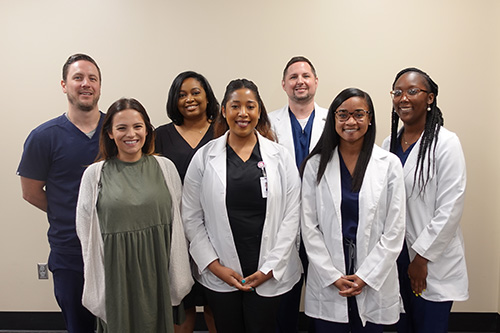
When Samford University’s Moffett & Sanders School of Nursing launched its nurse practitioner residency program in the midst of a global pandemic, faculty knew there would be challenges. Training would be virtual, and clinical sites could be limited. Yet despite every obstacle, the program successfully reached the end of its first year, and hindsight now reveals how the Lord guided and support them through it all.
The residency program originated after Moffett & Sanders School of Nursing was awarded the Advanced Nursing Education—Nurse Practitioner Residency Program Grant from the U.S. Department of Health and Human Services. The school received $3.5 million over a four-year period for the purpose of placing nurse practitioner residents in rural, underserved areas for primary care residency. At the time, it was the largest grant in Samford’s history.
The grant was received in July 2019, and just one year later, in July 2020, the program began with an inaugural cohort of 10 residents. The cohort represented a diverse range of experience and age, but they all shared a passion for serving in underprivileged settings.
Though faculty worried that clinical placements would be sparse, the Lord provided what they needed. Each resident had opportunities to train under an assigned nurse practitioner preceptor and collaborating physician to complete clinical hours in a medically underserved community. In addition to primary care sites, residents rotated through specialty training opportunities, including urgent care, women’s health, pain management, diabetes and orthopedic services. In total, residents gained experience in 19 clinics and worked at least 1,500 hours, serving an average of 2,000 patients each.
Residents also participated in more than 40 didactic lessons and lectures, led by faculty in Moffett & Sanders School of Nursing and other programs in Samford’s College of Health Sciences, including pharmacy, physical therapy, nutrition and dietetics and social work. And though many of the cohort’s interactions were virtual at first, they quickly bonded and became tight knit, like a family.
“I just want to say how grateful I am for this program. It was definitely the right choice for me, my family and my career. I feel like I’ve gotten to know my fellow residents very well, and I’m so grateful for them,” said resident Trey Fenley. “It’s amazing to be a part of something so God-centered. I’m extremely thankful for this opportunity, and that God led me here.”
“This residency came along at the right time. It allowed me to get my feet wet, and I feel much more confident today than I did a year ago,” said resident Scott Money.
At a final meeting in June, faculty and residents were able to celebrate all they were able to accomplish over the past year. “God opened the door for each of you to come here,” said Jessica Wukasch, the program’s health education coordinator. “We realize this year was filled with challenges, but you stuck with it. As a result, the residency program has been uniquely shaped by you, and we hope you have been deeply shaped by the program.”
“Samford’s residency program allowed me to work alongside some wonderful preceptors in various specialties,” said resident Emily Worthy. “I received a thorough hands-on experience with patients as well as a formal learning environment with weekly didactic sessions. I was able to leave my residency year feeling more competent, and knowing that I provide safe, competent, and compassionate care of complex patients is so rewarding.”
“We are incredibly proud of our inaugural residency cohort,” said Stephanie Wynn, professor, assistant dean for scholarly activity and nurse practitioner residency director. “Through the Nurse Practitioner Residency Program, we sought to enhance each resident’s clinical excellence and professional confidence. I believe this has been accomplished and that our residents will deeply shape the communities in which they serve.”
